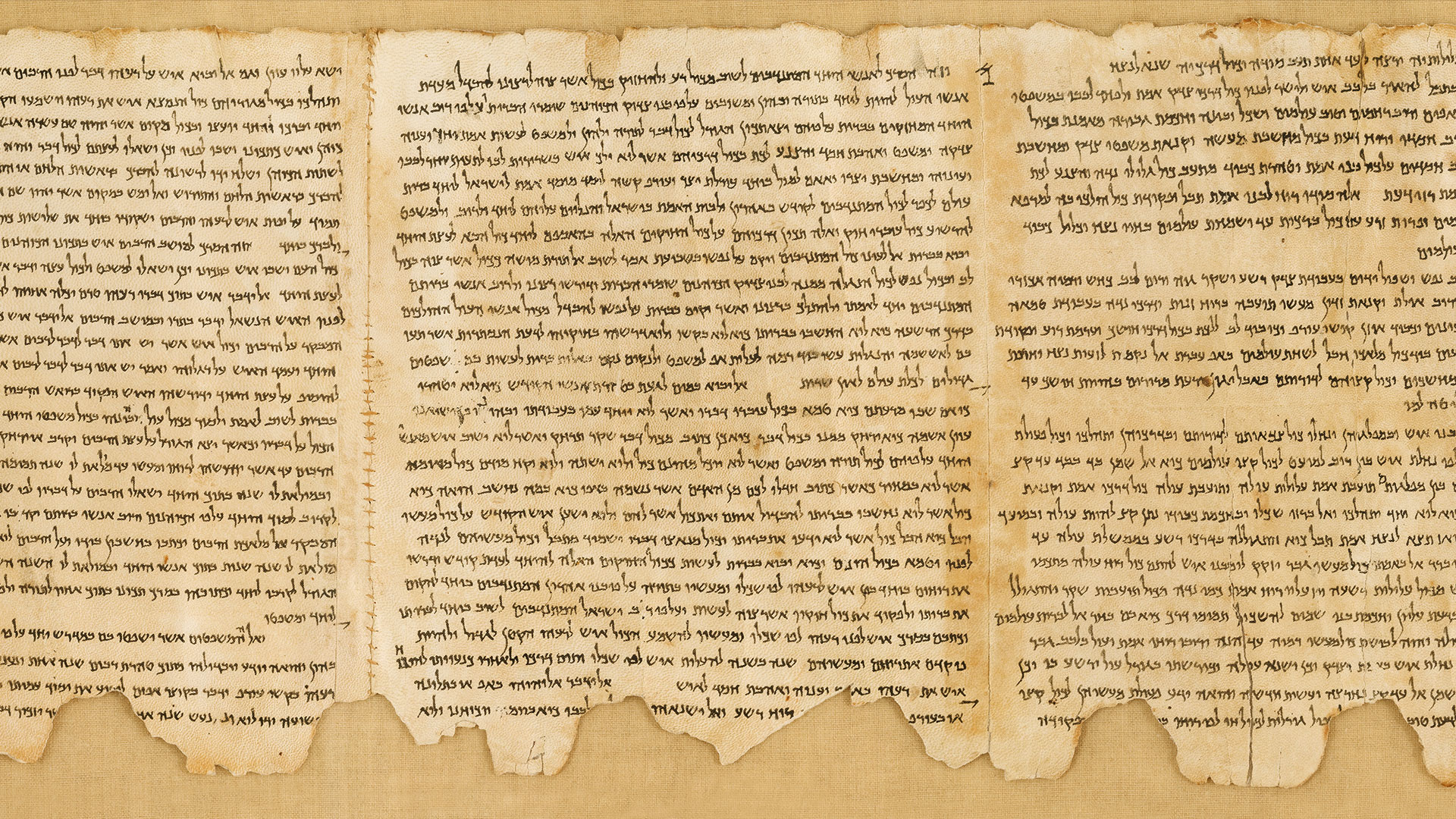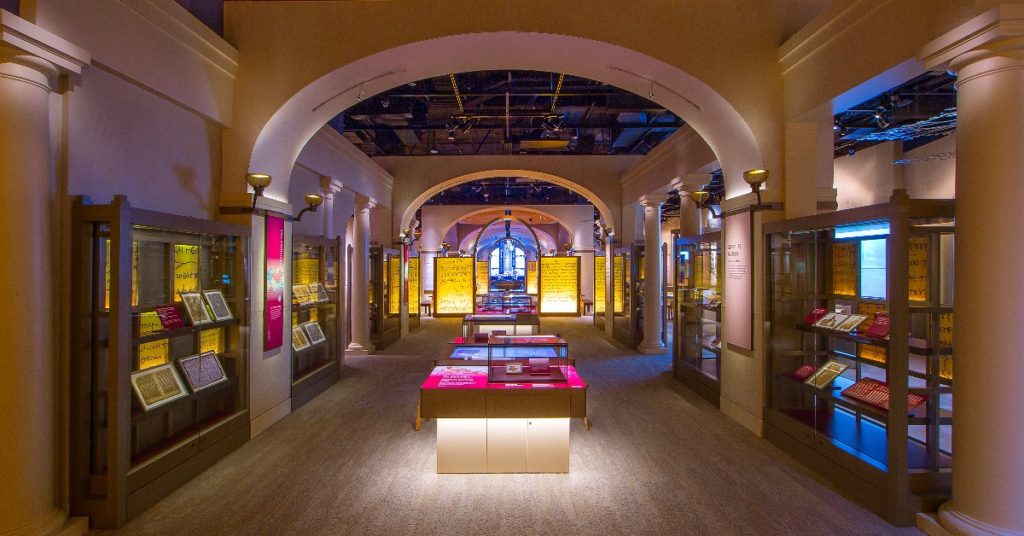
Premise 1 : The Old Testament is the most textually verified book written before Christ
Archaeologist have found literally tens of thousands of manuscripts and fragments of the Bible, some of these date as early as 600 B.C. which would be 3,525 years from 2022. The Bible has 2,000 percent more manuscript evidence than it’s closest historical competitor “The Iliad” by Homer.
For instance Plato’s work Tetralogies has 210 manuscripts. It was written between 408-310 B.C. with the earliest copy dated 1200 years after the original in A.D. 900. The Dead Sea Scrolls contain 900 Old Testament Manuscripts just in themselves. The Cairo Geniza Scrolls found in 1864 contain over 250,000 manuscript fragments of the Old Testament. The Bible is the most textually verified ancient book in the world by a huge margin.
Most other manuscripts of ancient books date from 500 to 1500 years after the original and the amount of ancient copies are very limited in number compared to the Bible. Here is a list of some of the most well known Bible manuscript collections— there are literally thousands more in museums and private collections.
List of Old Testament manuscripts that have discovered and researched to compose our modern Bible translations today
| Name | Date Of Copies | Bible Books |
| Dead Sea Scrolls | 250 BC-AD 68 | 900 biblical manuscripts from every book of the Old Testament except Esther |
| Isaiah Scroll A | 150-100 B.C | Complete Copy of the book of Isaiah |
| Rylands Papyrus 458 | 150 BC | Contains Greek portions of Deuteronomy 23-28 |
| Nash Papyrus | 150 BC-AD | Portion of the Decalogue (Exodus 20); Deuteronomy 5:6-21; Shema (Deuteronomy 6:4-9) |
| Peshitta | AD 100-200 | Entire Old Testament in Syriac |
| Codex Vaticanus | AD 325 | Entire Greek Old Testament except portions of Genesis, 2 Kings, Psalms |
| Codex Ephraemi Rescriptus | AD 345 | Contains Job, Proverbs, Ecclesiastes, Song of Solomon |
| Codex Sinaiticus | AD 350 | Half of the Old Testament in Greek |
| Latin Vulgate | AD 390-405 | Entire Old Testament in Latin |
| Codex Alexandrinus | AD 450 | Entire Old testament in Greek |
| Codex Cairensis | AD 850 | Joshua, Judges, Samuel, Kings, Isaiah, Jeremiah, Ezekiel, Hosea, Joel, Amos, Obadiah, Jonah Micah, Nahum, Habakkuk, Zephaniah, Haggai, Zechariah, and Malachi |
| Aleppo Codex | AD 900 | Complete Hebrew Old Testament |
| Codex Leningradensis | AD 1008 | Complete Hebrew Test Of Old Testament |
| Samaritan Pentateuch | 10th-11th Century AD | Genesis, Exodus, Leviticus, Numbers, Deuteronomy |
Remarkable facts concerning these ancient manuscripts
- They were written in a whole range of nations (Syria, Egypt, Rome, Israel, Africa, Greece, Armenia, Georgia, China)
- They were written in the most common languages of the day such as Greek, Hebrew, Latin, and Syriac, Coptic, Ethiopic, Slavic, and Gothic.
- There are copies from every century since 600 B.C. to 1 A.D
Most astonishingly— they all 90% textually agree which is textual verification that they came from a common textual ancestor and were faithfully transmitted. These are the very same manuscripts most major modern Bible translations such as the New American Standard, New International Version, English Standard Version and the King James Version Bibles were composed from.
Before the discovery of the Dead Sea Scrolls in 1946 the earliest complete Old Testament manuscripts were the Masoretic Text dated A.D. 980 A.D. 1008.
This collection of over 15,000 scrolls contains over 900 manuscripts of the Hebrew Bible which includes every book in the Old Testament with the exception of Esther. Paleographers were able to do side by side comparisons of each book and were astonished to find how little the biblical text has changed in over 1000 years of transmission.

In the Chart below you will find literal translation of Genesis 1:18-20 from the 1Q1 Genesis Scroll that were written in Hebrew then translated to English side by side with the King James Version which is the most read version of the Bible in the world. This side by side comparison is an example of the word for word translation philosophy used by translators to compose most modern Bible translations.
| Dead Sea Scroll Fragment | Date Written | Literal Translation From Hebrew to English | King James Version |
| 1Q1 Genesis 1:1-20 | 30 B.C | 19 There was evening and there was morning, a fourth day. 20 God said, “Let the waters abound with living creatures, and let birds fly above the earth in the open expanse of the sky.” | 19 And the evening and the morning were the fourth day. 20 And God said, Let the waters bring forth abundantly the moving creature that hath life, and fowl that may fly above the earth in the open firmament of heaven. |
It is a matter of wonder that through something like a thousand years the text underwent so little alteration
FF Bruce: British Biblical Scholar; Cambridge University
The enormous number of surviving copies has enabled experts to reconstruct the original with great accuracy and as a result for over 99% of the words of the Bible we know what the original manuscript said. The remaining less than 1% makes no difference to any biblical doctrine or teaching.
Challenge Question : Did you know there was so much archaeological data from ancient times to compare the textual accuracy of the Old Testament with?
Premise 2 : The New Testament has been preserved in more manuscripts than any other ancient work
Paleographers are specialized historians who study ancient texts such as Shakespeare, Beowulf, The Iliad and also the over 25,000 manuscripts New Testament manuscripts.
These over 25,000 ancient manuscripts and artifacts of the Bible are housed in various places such as the Vatican, Smithsonian Institute, and the Bodmar Library of World Literature plus many other renowned museums and libraries.

These various collections demonstrate that New Testament has been preserved in more manuscripts than any other ancient work. There are over 5,800 complete or fragmented Greek manuscripts, 10,000 Latin manuscripts and 9,300 manuscripts in various other ancient languages, such as Syriac, Slavic, Gothic, Ethiopic, Coptic and Armenian. These numbers do not reflect the numerous uncatalogued manuscripts contained in private collections around the world.
The next closest book to the New Testament in terms of manuscript support is the Illiad of Homer, which is attested to by 643 manuscripts, the oldest of these was made 500 years after the original.
We have more than 1,000 times the manuscript data for the New Testament than we do for the average Greco-Roman author
Dan Wallace; Executive Director Center for the Study of New Testament manuscripts
This statement is true; compared to the average Greco-Roman author, scholars have significantly more manuscript copies of the New Testament, often estimated to be over a thousand times greater in quantity
Google AI Overview
This chart shows that the Bible has exponentially more manuscript evidence and that it was written much closer to the time of the people and events it describes than all other trusted ancient historical works.
| Author | Ancient Title | Date Of Original | Earliest Manuscript | Time Gap From Original | Manuscript Copies In Existence |
| Plato | Dialogues | 4th Century BC | AD 900 | 1,250 years | 20 |
| Homer | Iliad | 9th Century BC | 400 BC | 500 years | 643 |
| Aristotle | Assorted Works | 4th Century BC | AD 1100 | 1,400 years | 5 |
| Thucydides | History Of The Peloponnesian Wars | 460 to 400 BC | AD 900 | 1,300 years | 8 |
| Aristophanes | Assorted Works | 448 to 385 BC | AD 900 | 1,300 years | 10 |
| Sophocles | Assorted Works | 496 to 406 BC | AD 1000 | 1,400 years | 193 |
| Julius Caesar | The Gallic Wars | 58 to 44 BC | AD 900 | 950 years | 10 |
| Tacitus | Annals of Imperial Rome | AD 58 to 120 | AD 1100 | 1,000 years | 20 |
| Pliny the Younger | History of Rome | AD 62 to 113 | AD 850 | 750 years | 7 |
| Suetonius | The Twelve Caesars | AD 70-140 | AD 950 | 900 years | 8 |
| New Testament | New Testament Manuscripts | AD 45 to 100 | AD 117 to 325 | 30-300 years | 25,000 plus |
The classical works listed on the charts are housed in the most respected Libraries and Universities in the world and are accepted as primary sources for the historical events they document even though most have less than a dozen manuscripts to compare and were authored by people who did not live during the times or events they write about.
The New Testament on the other hand, has 24,000 more manuscripts than it’s nearest competitor, and the majority of New Testament authors were intimates of Jesus —all lived during the time of his ministry and the events they write about.
To be skeptical of the resultant text of the New Testament books is to allow all of classical antiquity to slip into obscurity, for no documents of the ancient period are as well attested bibliographically as the New Testament
John Warwick Montgomery: Lawyer, Professor, Theologian
The origin of the over 25,000 New Testament manuscripts can be traced back to different parts of the world. Some in Egypt known as “Alexandrian”; others to Antioch of Syria, known as “Syrian or Byzantine”; and others to Western Europe which are called Western. These manuscripts and versions are the tools paleographers have used to restore the primitive text of the New Testament.
Even though the versions can be traced to different times, countries , and continents the 99.5% accuracy rate shows that they were faithfully transmitted from a common textual ancestor.
The manuscripts, the versions, citations from early Christian writings…using these tools with discretion, it is possible to come so near the original autographs that we can all but grasp them in our hand
Neil R. Lightfoot; How We Got The Bible
The vast number of manuscripts have allowed paleographers to use computerized analysis to document changes and alterations in the text over time. The Bible’s 99.5% textual accuracy is not a matter of speculation— it is hard proof that the common theory that “the Bible has been manipulated by man over time” is a false.
Challenge Question: Many people believe the Bible has been altered dramatically over time through copying and multi-translations. Doesn’t the fact paleographers have been able to certify 99.5% textual prove this is a false narrative?
Premise 3: The writings of Early Church Fathers also confirm faithful transmission of the text
The Early Church Fathers are a group of ancient and influential Christian theologians and writers who established the doctrinal foundations of Christianity. The historical period they wrote in was called the “Patristic Period” during the 1st-8th centuries beginning when most of the New Testament books were first published.
The Early Church Fathers wrote extensively about Christianity and quoted directly from the New Testament using older manuscript copies than we have today. Numerous volumes of their writings have been preserved and are filled with direct and literal quotations from the New Testament.
All 27 books of the New Testament are quoted, addressed and validated by the writings of the Early Church Fathers.
Here is a chart showing the number of direct quotes from each Church Father and the books of the New Testament they directly quoted from:
| Writer | Date | Gospels | Acts | Pauline Epistles | General Epistles | Revelation | Totals |
| Justin Martyr | 100-165 A.D | 268 | 10 | 43 | 6 | 266 | 330 |
| Iraneus | 130 A.D | 1,038 | 194 | 499 | 23 | 65 | 1,819 |
| Clement | 1,017 | 44 | 1,127 | 207 | 11 | 2.406 | |
| Origen | 254 AD | 9.231 | 349 | 7,778 | 399 | 165 | 17,922 |
| Tertullian | 160 A.D | 3,822 | 502 | 2,609 | 120 | 205 | 7,258 |
| Hippolytus | 236 A.D | 734 | 42 | 387 | 27 | 188 | 1,378 |
| Eusebius | 265 A.D | 3,258 | 211 | 1,592 | 88 | 27 | 5,176 |
| Totals | 19,368 | 1,392 | 14,035 | 870 | 664 | 36,289 |
Not only does the New Testament outnumber the total of all other ancient works (932) by over 24,000 manuscripts—we have volumes of the writings of the Early Church Fathers containing over 36,000 direct quotes from every book in the New Testament.
So extensive are these citations that if all other sources for our knowledge of the text of the New Testament were destroyed, they would be sufficient alone for the reconstruction of the entire New Testament
Bruce Metzger
You could literally reconstruct the entire New Testament using the 32,000 direct quotations from the Early Church Fathers, with the exceptions of a few dozen verses. By comparing all of the thousands of New Testament manuscripts along with this vast amount of direct quotations from ancient biblical scholars from the same era, paleographers are able to verify that the the New Testament we have today has been faithfully transmitted.
Challenge Question : Did you realize that so many ancient Bible manuscripts were used to translate and compose our modern translations to assure 99.5% accuracy in transmission?
Premise 3 : The Bible is the most textually authenticated piece of literature from the ancient world.
Virtually all the texts that have survived from ancient times have survived only through later copies. Therefore every book or document from sources such as; Shakespeare, Chaucer, Plato, or Homer can only have their accuracy tested by comparing copies since there is no original.
This process of comparison is called the bibliographic test which is the primary method historians use to verify the textual accuracy of ancient documents. The bibliographic test looks at the ancient manuscripts of the Bible and asks whether the text of the Bible we have today is the same as the original.
Combining both the Old and New Testament, there are more than 66,000 manuscripts and scrolls to compare and authenticate original text and meaning. Of just the 5,800+ Greek New Testament manuscripts there are more than 2.6 million pages.
If you were to stack all of the manuscripts of all the other academically accepted ancient works it would measure 2 feet high. If you stacked all of the manuscripts of the New Testament alone it would measure over 3,937 feet high or 4 1/2 empire state buildings stacked on top of each other.
The Art Of Textual Criticism
Textual criticism is a branch of textual scholarship that concerns itself with identifying textual errors, variants or different versions of manuscripts or books. A textual critic searches for the best surviving texts or the earliest readings from multiple sources. The documents are compared and differences noted. In the case of the Bible paleographers have compared the 2.6 million pages to attempt to establish it’s original rendering.
While is seems like a super complicated process—in some ways it is simple. One way of understanding the process is to pretend you have a hundred of the same jigsaw puzzle but each having either a few missing pieces, or the wrong ones. When you lay all 100 mostly completed puzzles alongside each other it becomes easy to see by comparing them which pieces don’t fit. The Bible has 25,000 manuscripts to compare more than 24,000 more than all other accepted ancient works combined. Now translators can use Artificial Intelligence technology to assess the accuracy of a translation.
Scholars, historians, paleographers, and theologians have had centuries to analyze this enormous trove of Scriptural content to confirm the accuracy of our English editions of the Old and New Testament. Using computer technology, large manuscript databases and direct quotations they have been able to reconstruct the original text and verify that it is 95-99% accurate.
No book has undergone more extensive bibliographic testing than the Bible. No ancient book has more copies to compare or more paleographers or historians to apply the bibliographic test. Not even close!
The importance of the sheer number of manuscripts and early patristic quotations of Scripture cannot be overstated. As with other documents of ancient literature, there are no known extant original manuscripts of the Bible. Fortunately, however, the abundance of manuscript copies makes it possible to reconstruct the original text with virtually complete accuracy.
Norman Geisler and William Nix: A General Introduction To The Bible
The 3 main factors that give scholars confidence in the text of the Bible
- The vast number of manuscripts is hugely advantageous when trying to determine the original reading of the Bible
- The Bible surpasses the Bibliographic Test far more than other Ancient Works
- Scribal errors or (variants) after systematic analysis by un-competing experts do not overturn any narrative or doctrine of the Bible
Challenge Question : According to most biblical scholars, the percentage of transmission errors in all ancient Bible manuscripts combined is considered to be extremely small, with estimates placing it at less than 1% of the total text, meaning that over 99% of the Bible’s content is considered reliably preserved across various manuscripts. Does this help to instill confidence that it has been faithfully tranmitted?
ThinkCube Truth Veracity Grid
- Have I considered the facts carefully and with an open mind?
- Is my conclusion the result of a careful examination of the facts, or is it a conclusion made in spite of the facts?
